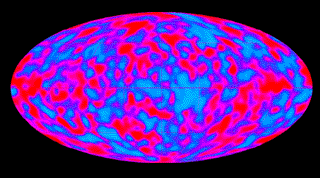|
Predicted by George Gamow and his collaborators in the 1940s and detected by Arno Penzias and Robert Wilson in the 1960s, the cosmic background radiation is the faint echo of the Big Bang. Following the explosive birth of our cosmos, the universe both expanded and cooled off rapidly. After roughly 300,000 years, its temperature had fallen to about 3000 kelvin (5000° Fahrenheit) and a big change was taking place. Before this time, conditions were too hot for atoms to form—protons and electrons each went their separate ways—and photons of light could travel only short distances before interacting with the free electrons. It was as if the universe existed in a thick fog that kept light from penetrating. But when the temperature reached 3000 kelvin, atomic nuclei finally captured electrons and formed stable atoms. Photons were then able to travel unimpeded—the fog lifted—and the universe became transparent to light. It’s that light we see as the background radiation, coming at us from all directions. However, in the 10 billion or more years since the Big Bang, the universe has expanded by a factor of a thousand, causing the temperature of the radiation to fall by the same amount. It now glows at just 3 kelvin (3° Celsius above absolute zero) in the microwave part of the electromagnetic spectrum, a faint reminder of our universe’s hot start. The background appears very smooth, varying by only one part in 100,000 across the sky.
|
|
